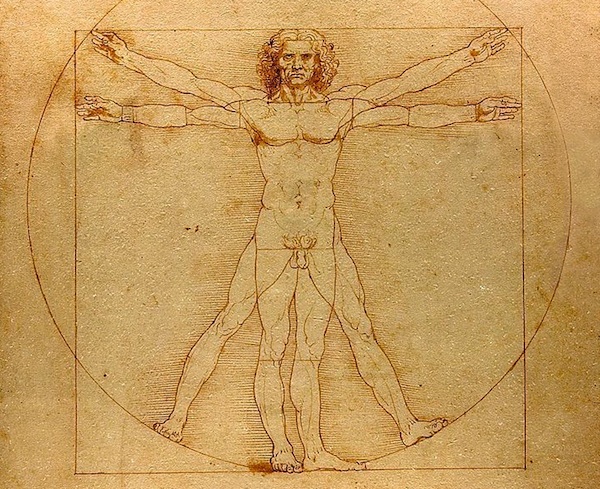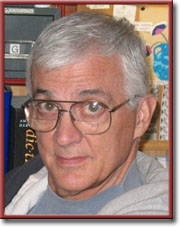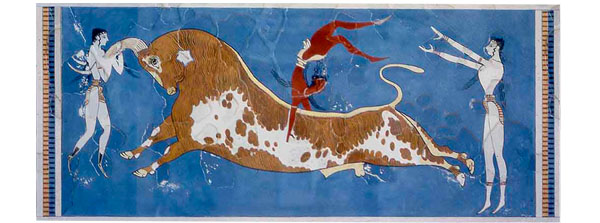A Log with Nine or Ten Knotholes: Defining Man
Skip the B.S.
By Skip Eisiminger

“In nature’s eyes, humans are as expendable as any of the 8.7 million species on the planet. And yet, is there another mammal who can do a back flip through a basketball net uninjured, take twelve strides across a lake’s surface without sinking, do a series of backflips on a pogo stick, and execute a one-finger pull-up?” Skip Eisiminger
In making man, God may have overestimated His ability.—paraphrase of Oscar Wilde
Man is the latest and best manifestation of God.—paraphrase of Samuel Butler
 CLEMSON South Carolina—(Weekly Hubris)—5/6/2013—In his famous Study of Human Proportions (c.1490), Leonardo da Vinci fit a symmetrical male into a circle and square: two perfect, basic geometric forms. Why he did not also draw this human paragon inside an equilateral triangle is a subject for another essay, but the short answer is: twice perfect is sufficient.
CLEMSON South Carolina—(Weekly Hubris)—5/6/2013—In his famous Study of Human Proportions (c.1490), Leonardo da Vinci fit a symmetrical male into a circle and square: two perfect, basic geometric forms. Why he did not also draw this human paragon inside an equilateral triangle is a subject for another essay, but the short answer is: twice perfect is sufficient.
The contemporary cartoonist Arnold Roth, however, got a bit closer to the truth of our species when he drew some hopefuls auditioning for the job of Leonardo’s model. From the assembled line-up, it’s clear that only one fellow out of seven will fit perfectly inside the frames. And while one in seven is close to the number of fit males these days, there’s no way to know whether the physical prodigy who gets the job isn’t a serial killer. Don’t forget that Ted Bundy was that handsome “square” peg who fit the “circle” so well no one suspected he would cut your throat.
As a short-waisted, 6’ 3” male with legs more suitable for someone 6’ 7”, I’ve had 50 years to contemplate the injustice of nature’s proportions. Playing off the psalmist’s belief that humans are just “a little lower than the angels,” John Barth thought there was a fair chance that humanity is “a pimple on an angel’s ass.” To make a similar point in 1996, the Copenhagen Zoo invited two Homo sapiens sapiens to live in a Plexiglas cage between its baboons and lemurs. The couple accepted and stayed three weeks. A cynical Mark Twain thought God made man because he was disappointed with the monkey until he remembered that man was made when God was exhausted. Being made on the sixth day, Twain implied, is a little like an automobile being assembled on a Friday afternoon.
However, if equality were absolute in nature that would eliminate the Paganinis with 18-inch hand spans, the Michael Jordans with 48-inch vertical leaps, and the Swami Buas capable of blowing a continuous tone on a conch shell for eight days. His trick, he said, was to “breathe through the eyes.” Now if you find yourself jealous of Bua’s breath control, you might console yourself in the knowledge that he spent much of his life twisted into various yoga poses. Surely, humans can do better.
Despairing of ever meeting an attractive woman, T.S. Eliot’s J. Alfred Prufrock longed to be a crab scuttling across the sea floor. But isn’t that the reality principle: an infestation now grown to seven billion walking about under an ocean of air with 14.7 psi on our shoulders? Matthew Arnold’s opinion of us wasn’t quite that miserable; he thought man was a “hairy quadruped” disposed to Greek. Plautus, on the other hand, thought man a wolf, and Roy C. Andrews defined us as “an ape with possibilities.” Many writers have made similar comparisons to our animal neighbors only to conclude that we are superior because we either cook, record history, pray, leave quasi-permanent traces of ourselves, wear pants, or play poker. Indeed, some of us accomplish all of the above.
Despite what Galileo, Darwin, and Freud wrote to make man feel peripheral, we still thought ourselves special because we used tools until we learned that chimpanzees, otters, and ravens use them as well. Then we thought our speech set us apart until we discovered that dolphins and whales communicate very efficiently with sound waves. Waging war was surely distinctive, we thought, until we saw that ants and chimps are as territorial as we are. Finally, we thought man is unique because we contemplate death. Indeed we do but, apparently, so does the elephant.
In nature’s eyes, humans are as expendable as any of the 8.7 million species on the planet. And yet, is there another mammal who can do a back flip through a basketball net uninjured, take twelve strides across a lake’s surface without sinking, do a series of backflips on a pogo stick, and execute a one-finger pull-up? (For more, see YouTube.) Dolphins swim five times faster than man, cheetahs run two times faster, and gorillas are six times stronger, but can any one of them swim, bike, and run 140 miles in under 17 hours? Iron Man triathletes do it routinely. Man alone has survived at 30,000 feet without supplemental oxygen, dived 328 feet below sea level with no artificial support, survived a 30 percent blood loss, a 30 percent weight loss, three weeks without food, and two weeks without water.
In a cartoon drawn by Charles Barsotti, a dog says to his son, “Yes, they are crazy, but they can open the fridge.” Beside the sperm and egg, nature only needs enough iron for an eight-penny nail, carbon for 9,000 pencil leads, and fat for eight bars of soap to make another human. The estimated cost ranges from a low of $.97 to $310,000,000—it depends on the expert you ask.
Carl L. Becker’s estimation of the species would come in at the lower end of that range after observing that, “Man is a chance deposit on the surface of the world, carelessly thrown up between two ice ages by the same forces that rust iron and ripen corn.”
However, Shakespeare’s assessment would surely be higher judging from what he wrote about us in Hamlet, “What a piece of work is a man, how noble in reason, how infinite in faculties, in form and moving how express and admirable, in action how like an angel,in apprehension how like a god, the beauty of theworld, the paragon of animals . . . .”
Finally, there are those like Ted Bundy who are more difficult to classify. Bundy, killer of at least 30 young women of infinite cost, never assigned life except his own any value. When someone asked him if he felt any remorse for the innocents he killed, the puzzled convict replied, “I mean, there are so many people.” Like all lovelorn killers, he failed to understand the survivors’ grief and anger, given that, as he might say, “With billions to draw from, who’s going to miss 30?”
Like Jonathan Swift, who “detested man,” I abhor what my ancestors did to the Native Americans who preceded us on this continent and the African slaves imported to make a profit from it but, like Swift, who loved “John, Peter, [and] Thomas,” my life is immeasurably richer owing to my wife, our children and grandchildren, hubristic friends, and dozens more alike. It’s tragic when people just don’t get it.
